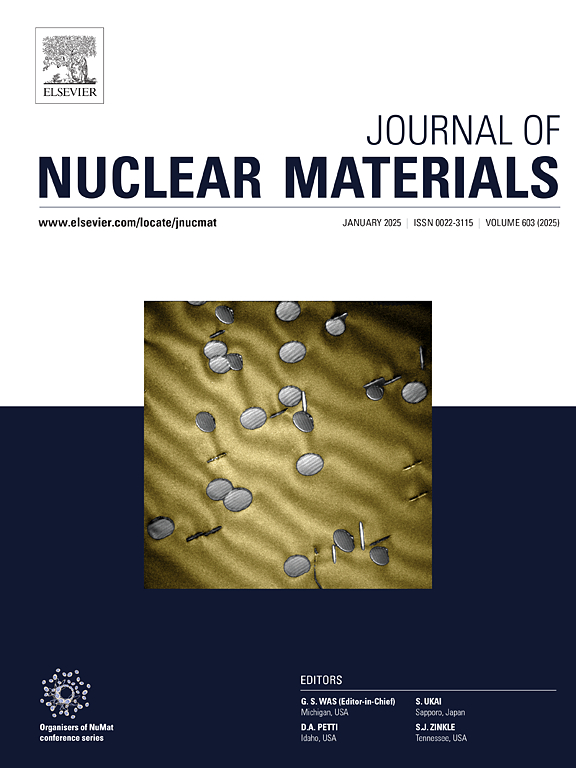Differential effects of Si/dpa ratio on the evolution of dislocation loops in Al-2.64 Mg alloy during in-situ irradiation
IF 2.8
2区 工程技术
Q3 MATERIALS SCIENCE, MULTIDISCIPLINARY
引用次数: 0
Abstract
Transmutated Si element is an important issue in the neutron irradiation of Al alloys. The Si production per dpa has been noticed to vary with the neutron energy spectrum, but the effect of Si/dpa ratio on the dislocation loop evolution has been rarely studied. In this work, the effect of Si/dpa ratio in Al-2.64 Mg alloy is in-situ quantitatively investigated by Si+ irradiation at 100 °C with 1665, 468, and 57 appm/dpa. The higher the Si/dpa ratio, the smaller the loop size, but the higher the loop density in the matrix, which can be attributed to the high Si/dpa ratio leading to more lattice distortion and nucleation sites. Dislocation loops are preferentially formed around Al9Fe2-xNix precipitates due to the lattice mismatch at the interface. This phenomenon is more obvious at the low Si/dpa ratio. While Mg2Si precipitates have less effect on the formation of loops regardless of the Si/dpa ratio, because Al/Mg2Si interfaces are more likely to form a semi-coherent orientation and only result in mild lattice mismatch. But the type of dislocation loops is not affected by the lattice distortion and mismatch. In general, the Si atoms existed in Al lattice can significantly affect the dislocation loop evolution depending on the Si/dpa ratio. The current Si+ irradiation results provide valuable data for understanding the transmutation behavior of Al alloys.

原位辐照过程中Si/dpa比对Al-2.64 Mg合金位错环演化的差异影响
硅元素嬗变是铝合金中子辐照中的一个重要问题。每dpa的Si产量随中子能谱的变化而变化,但Si/dpa比值对位错环演化的影响很少被研究。本文采用1665、468和57 appm/dpa的Si+辐照,在100℃下原位定量研究了Si/dpa对Al-2.64 Mg合金的影响。Si/dpa比越高,环的尺寸越小,但环的密度越大,这是由于Si/dpa比越高导致晶格畸变和成核位点增多所致。由于界面处的晶格失配,在Al9Fe2-xNix析出物周围优先形成位错环。这种现象在Si/dpa较低时更为明显。而无论Si/dpa比如何,Mg2Si析出物对环路形成的影响较小,因为Al/Mg2Si界面更容易形成半相干取向,只导致轻微的晶格失配。但位错环的类型不受晶格畸变和错配的影响。总的来说,Si原子存在于Al晶格中会显著影响位错环的演变,这取决于Si/dpa比。目前的Si+辐照结果为了解铝合金的嬗变行为提供了有价值的数据。
本文章由计算机程序翻译,如有差异,请以英文原文为准。
求助全文
约1分钟内获得全文
求助全文
来源期刊

Journal of Nuclear Materials
工程技术-材料科学:综合
CiteScore
5.70
自引率
25.80%
发文量
601
审稿时长
63 days
期刊介绍:
The Journal of Nuclear Materials publishes high quality papers in materials research for nuclear applications, primarily fission reactors, fusion reactors, and similar environments including radiation areas of charged particle accelerators. Both original research and critical review papers covering experimental, theoretical, and computational aspects of either fundamental or applied nature are welcome.
The breadth of the field is such that a wide range of processes and properties in the field of materials science and engineering is of interest to the readership, spanning atom-scale processes, microstructures, thermodynamics, mechanical properties, physical properties, and corrosion, for example.
Topics covered by JNM
Fission reactor materials, including fuels, cladding, core structures, pressure vessels, coolant interactions with materials, moderator and control components, fission product behavior.
Materials aspects of the entire fuel cycle.
Materials aspects of the actinides and their compounds.
Performance of nuclear waste materials; materials aspects of the immobilization of wastes.
Fusion reactor materials, including first walls, blankets, insulators and magnets.
Neutron and charged particle radiation effects in materials, including defects, transmutations, microstructures, phase changes and macroscopic properties.
Interaction of plasmas, ion beams, electron beams and electromagnetic radiation with materials relevant to nuclear systems.
 求助内容:
求助内容: 应助结果提醒方式:
应助结果提醒方式:


